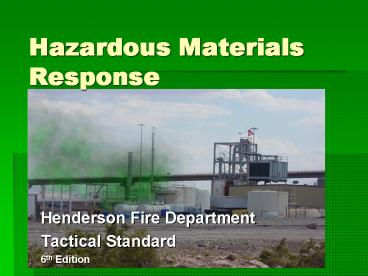Hazardous Materials Response PowerPoint PPT Presentation
1 / 38
Title: Hazardous Materials Response
1
Hazardous Materials Response
- Henderson Fire Department
- Tactical Standard
- 6th Edition
2
Objectives
- Explain Operations Level responsibilities
- Identify hazmat jurisdictional Incident Command
responsibilities - Describe the 3 levels of hazmat incidents
- Name the resources utilized to identify hazardous
materials - Recognize common hazmat containers
- Define isolation perimeter, initial isolation
zone and protective action distance - Explain the 3 scene control zones
- Describe defensive control actions
3
Objectives continued
- Identify the differences between gross decon,
emergency decon, technical (formal) decon, and
mass decon. - Define the 3 hazmat incident strategies
- Explain the difference between immediate concerns
and primary objectives - Identify the 9 DOT/UN Hazard classes
- Define a polymerization reaction
- Explain the management components of a hazmat
incident - Utilize Hazmat IQ system
4
Overview
- Henderson Fire Hazmat Training
- Hazmat Potential
- Training Level
- Incident Command Responsibilities
5
Incident Levels
- Level I Incident
- HFD only
- Level II Incident
- Hazmat Team
- Level III Incident
- State or Feds
6
Identifying Hazmat
- Marking Systems
- DOT/UN Marking System
- NFPA 704
7
DOT/UN Marking System
- 9 Hazard Classes
- 3 Packing Groups
- Placards
- Labels
- 2 Tables
- Identification Numbers
8
NFPA 704 System
9
Reportable Quantity (RQ)
- 5 Categories
- National Response Center (NRC)
10
Information Resources
- Hazmat IQ System (HMIQ)
- Emergency Response Guidebook (ERG)
- NIOSH Pocket Guide (NPG)
- Cameo Chemical Software
- WISER online
- Material Safety Data Sheets (MSDS)
- Shipping Papers
11
Scene Control
- Isolation Perimeter
- Solids 75ft
- Liquids 150ft
- Gases 330ft
- Explosives ½ mile (800 yards)
- Initial Isolation Zone
- Protective Action Zone
- Hazard Control Zones
- Hot, Warm, Cold
12
Isolation Perimeter
- Unknown Chemical
- Solids 75ft
- Liquids 150ft
- Gases 330ft
- Explosives ½ mile (800 yards)
13
Initial Isolation Zone
- ERG
- Known Chemical
- Less than 30 minutes not on fire
14
Protective Action Zone
- ERG
- Less than 30 minutes not on fire
- Evacuation
- Shelter-in-place
15
Hazard Control Zones
- Hot
- Warm (contamination reduction zone)
- Cold Zone (support)
16
Spill Control/Confinement
- Absorption
- Blanketing/Covering
- Dike/Dam/Diversion/Retention
- Vapor Suppression
- Ventilation
- Vapor Dispersion
- Dilution
- Dissolution
17
Decontamination
- 4 Types
- Gross Decon
- Emergency Decon
- Technical (formal) Decon
- Mass Decon (wet dry)
18
Gross Decon
19
Emergency Decon
- HFD Emergency Decon Procedure
Clothes, PPE Equip.
Entry Team
Cleaning Team
Litter Team
Rescue Crew
Victim
Hot Zone
Warm Zone
Cold Zone
20
Emergency Decon Single Engine Entry
Clothes, PPE Equip.
Rescue Crew
Entry Team
Cleaning Team
Victim
Hot Zone
Warm Zone
Cold Zone
21
Technical (formal) Decon
22
Mass Decon (wet)
Warm Zone
Hot Zone
Cold Zone
23
Mass Decon (dry)
24
3 Hazmat Strategies
- Non-intervention
- Defensive
- Offensive
Note Line-of-sight Rescue
25
Immediate Concerns Primary Objectives
- Immediate Concerns (Ops level)
- Isolate the area deny entry
- Evacuate or shelter-in-place
- Dike/dam/divert runoff
- Eliminate ignition sources
- Cool tanks if appropriate
- Primary Objectives (typically not Ops level)
- Extinguish fires
- Control gas or vapor clouds
- Stop leaks (plug or patch)
- Turn off valves
26
Hazard Classes
- Explosives
- Gases
- Flammable Combustible Liquids
- Flammable Solids, Dangerous When Wet
Spontaneously Combustible - Oxidizers and Organic Peroxides
- Poisonous (Toxic) and Infectious
- Radioactive
- Corrosive
- Miscellaneous
27
Class 1 - Explosives
- Identification (1.1 1.6)
- Initial Isolation Perimeter ½ mile
- Explosive incident no fire
- Explosive incident involving fire
- Explosives detonated
28
Class 2 Gases
- Identification 2.1, 2.2, 2.3
- Initial Isolation Perimeter Gases 330ft
- Bleve concern
- Do not extinguish flame from relief valve
- Flammable gas incidents
- No fire or with fire
- LPG leaks
- Natural gas leaks in a home
- Natural gas leaks outside
29
Class 3 Flammable Combustible Liquids
- Identification
- Initial Isolation Perimeter Liquids 150ft
- Flammable Combustible Liquid Incidents
- No fire
- Involving fire
30
Class 4 Flammable Solids, Dangerous When Wet,
Spontaneous Combustibles
- Identification 4.1, 4.2, 4.3
- Initial Isolation Perimeter Solids 75ft
- Incidents Involving Class 4 Materials
- No fire
- Involving fire
31
Class 5 Oxidizers and Organic Peroxides
- Identification 5.1 5.2
- Initial Isolation Perimeter Solids 75ft,
Liquids 150ft - Incidents Involving Class 5 Materials
- No fire
- Involving fire
32
Class 6 Poisonous Infectious Materials (Toxic)
- Identification 6.1 6.2
- Initial Isolation Perimeter Solids 75ft,
Liquids 150ft - Incidents Involving Class 6 Substances
- No fire
- Involving fire
33
Class 7 Radioactive
- 3 Types Alpha, Beta Gamma
- Identification Radioactive I, II, III
- 2 Packaging Categories Type A B
- Initial Isolation Perimeter Start at 330ft
refer to ERG - Incidents Involving Radioactive Material
- ALARA
- No fire
- Involving fire
34
Class 8 Corrosives
- Identification pH, placard, research
- Initial Isolation Perimeter Solids 75ft,
Liquids 150ft - Incidents Involving Corrosives
- No fire
- Involving fire
35
Class 9 Miscellaneous
- Identification placard (black white vertical
stripes on top solid white lower) - Initial Isolation Perimeter Solid 75ft, Liquid
150ft, Gases 330ft
36
Polymerization
- Identification
- P after ERG guide number,
- Presence of sign in formula,
- Stated in Incompatibilities/Reactivities (NIOSH),
- Heat gun (increasing temp)
- Incidents involving a polymerization reaction
- Isolate area deny entry
- Confirm polymerization
- Identify material
- Evacuate area
37
Managing Hazmat Incident
- Basic Response
- Know your limitations
- Dispatch information
- Additional information
- Resources
- Pre-entry observation stop
- On scene
38
Hazmat IQ
- Hazmat IQ PowerPoint located on SharePoint.

